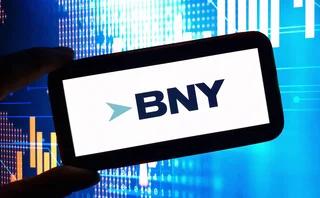
Q&A: How the west was won
Paul Lyon talks with Matt Ginsburg, Wells Fargo managing director of equity-linked products, about how he is building the San Francisco-based bank's structured products business

Wells Fargo has $428 billion in assets and more than 6,000 branches, mostly in the western US. And the bank is making a concerted effort to make the most of this impressive distribution network for its structured products business, says Matt Ginsburg, managing director of equity-linked products.
Last year, the bank, a popular site in any Californian town, issued nine retail market-linked issues, with an average issue size of around $30 million. And the number of issues is set to rise with increased acceptance of structured products by the US investing public, Ginsburg adds.
Q: What is the background to the structured products business at Wells Fargo?
A: The structured products business at Wells Fargo began in 2002. Originally, WF sold equity-linked notes issued by other banks. However, we soon began hearing from our sales people that a Wells Fargo product would be well-received by our clients. Hence, later in 2002, we began to issue equity-linked notes. Our first issue was very successful, and since then we probably offered about 20 different market-linked notes.
Our structuring team is small. But we get lots of help from the trading desks and other groups inside the bank, such as treasury, accounting and legal. And, of course, we would not be at all successful without the sales team we have in our private clients services group.
Although we began by issuing equity-linked notes, we've since branched out to offer inflation-, commodity- and currency-linked notes. And we won't stop there. We are going to move into hedge funds, credit and then circle back and think about where we can apply CPPI technology. In sum, we're going to make sure every excellent investment opportunity in the structured products space is made available to our clients.
Q: How do you go about structuring equity-linked notes? Are the derivatives components bought from Wells Fargo itself or do you also buy from other dealers?
A: Our structuring process is probably unique in that sometimes we hedge our deals in-house and sometimes we buy our hedge from the Street. In the equity space, we would hedge a domestic index or basket in-house, but we would look to the Street to help with an international index or basket. Outside of domestic equities and fixed income, we would be inclined to work with the Street because our capabilities are more limited. Because we're open to working with the Street, the types of products we can offer to our clients are unlimited.
Q: What do you see as the major challenges towards growing the US structured products business?
A: The hardest thing is that structured products are not generally considered an asset class. Each product is associated with the market upon which it is linked. Hedge funds exploded because they were recognised as a new asset class. If structured products can find a place within the traditional asset allocation models, then our business will not only grow dramatically, but it will also become more stable.
Generally, structured products offer more value and variety than mutual funds. But as exchange-traded funds (ETFs) become more popular, we'll have to be sure to offer similar value. Fortunately, the ETF spectrum is pretty limited, and it will probably be uneconomic to offer ETFs in every corner of the market. Hence, as a combination of value and variety, structured products are here to stay. We need to convince the asset management folks of this.
Q: There has been a lot of talk about multi-asset class structured products. Do you think the investing public is ready to take to them?
A: Some clients are ready, but at least in the US, investors are pretty traditional. I think they will need to read or hear about these products in the financial press and if the commentary is good, then sales will build. Outside the US, investors seem much more experimental, so multi-asset class products will probably do very well.
Q: How is Wells Fargo building its structured products business and which areas will growth come from in 2005?
A: We are not going to abandon our base, which is the conservative investor looking to get exposure to an unfamiliar market with principal protection. However, we're likely to offer a greater percentage of products outside the equity space because we've been focusing on this for the past two years. Commodity, currency and hedge fund-linked products will definitely be on our agenda this year. If credit spreads widen, we'll look at credit-linked structures as well. And we're going to introduce CPPI structures wherever that technology makes sense.
Thus far, our market has been the median-high-net-worth segment. We intend to penetrate the mass affluent and even the institutional market. Obviously, we will have to examine a lot of different products to offer quality investments to such a wide variety of clients. But, that's what makes our job so much fun.
Q: Finally, how did you become involved with the structured products business and how have you seen the market change?
A: Over the years the market has changed dramatically. Today, derivatives and structured products are widely accepted. Certainly in Europe, structured investments are ubiquitous. You can buy them in the Post Office or even a supermarket. I think they will also become much more widespread in the US in coming years.
I've been working with derivatives since I joined Bankers Trust (BT) in the 1980s. I spent almost 13 years with the firm in New York and London before coming to the West Coast. Being at BT, especially in the early years, was a unique experience. We really felt that we were revolutionising finance and risk management.
Many of my former BT colleagues are now running structured products desks at other firms. As a result I often find that I'm doing business with old friends.
Only users who have a paid subscription or are part of a corporate subscription are able to print or copy content.
To access these options, along with all other subscription benefits, please contact info@risk.net or view our subscription options here: http://subscriptions.risk.net/subscribe
You are currently unable to print this content. Please contact info@risk.net to find out more.
You are currently unable to copy this content. Please contact info@risk.net to find out more.
Copyright Infopro Digital Limited. All rights reserved.
As outlined in our terms and conditions, https://www.infopro-digital.com/terms-and-conditions/subscriptions/ (point 2.4), printing is limited to a single copy.
If you would like to purchase additional rights please email info@risk.net
Copyright Infopro Digital Limited. All rights reserved.
You may share this content using our article tools. As outlined in our terms and conditions, https://www.infopro-digital.com/terms-and-conditions/subscriptions/ (clause 2.4), an Authorised User may only make one copy of the materials for their own personal use. You must also comply with the restrictions in clause 2.5.
If you would like to purchase additional rights please email info@risk.net
More on People
Nomura shuffles risk methodology team
Epperlein takes advisory role six months after Japanese bank’s FRTB IMA go-live
Andy Ross leaves StanChart
CurveGlobal veteran confirms his departure as bank’s global head of prime brokerage
People moves: BofA’s new markets heads, Barclays takes SG’s Mastrangelo, and more
Latest job changes across the industry
People: BNY taps Nasdaq CRO for enterprise risk role, Hoornweg steers StanChart CIB solo, and more
Latest job changes across the industry
People: Nomura’s rates rebuild continues, DB USA’s new CEO, and more
Latest job changes across the industry
JP Morgan’s credit structuring head departs
Denis Gardrat will head infrastructure investor Rivage Investment’s UK unit
UBS sterling rates head joins RBC Capital Markets
Ian Hale joins the Canadian bank as head of European inflation trading
People: Rates revamp at Nomura, JP’s structuring shuffle
Latest job changes across the industry







